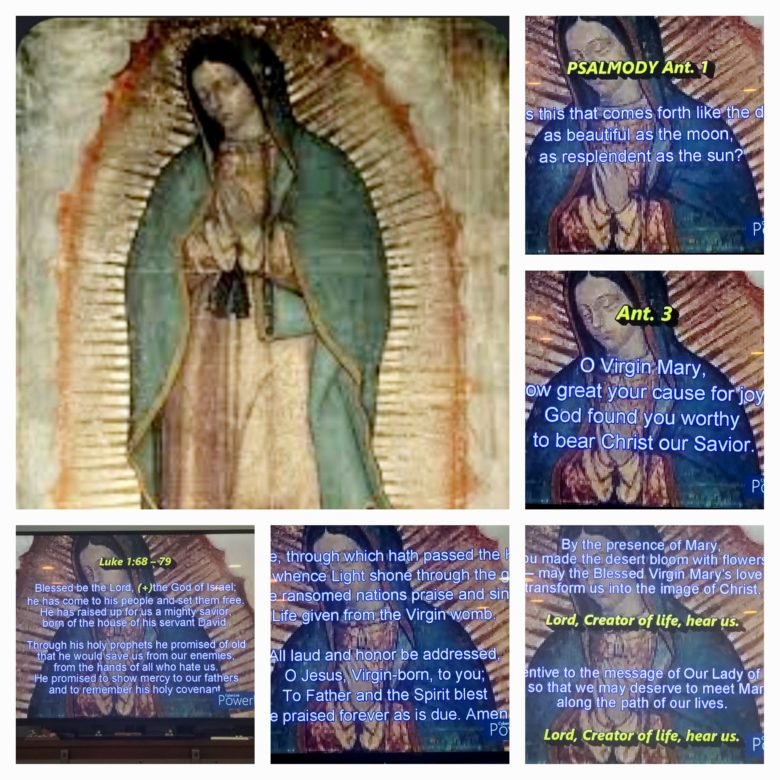Feast of Our Lady of Guadalupe
December 12 is the Feast of Our Lady of Guadalupe, one of many Toponymic Marian Titles for Mary, the mother of Jesus. In Christianity, Mary is known by many different titles, epithets, invocations, and several names associated with places. All of these descriptives refer to the same woman named Mary, the mother of Jesus Christ. The Virgin of Guadalupe has been proclaimed “Queen of Mexico”, “Patroness of the Americas“, “Emppress of Latin America”, and “Protectress of Unborn Children”
December 12 is the Feast of Our Lady of Guadalupe, one of many Toponymic Marian Titles for Mary, the mother of Jesus. In Christianity, Mary is known by many different titles, epithets, invocations, and several names associated with places where she has appeared. All of these descriptives refer to the same woman named Mary, the mother of Jesus Christ. The Virgin of Guadalupe has been proclaimed “Queen of Mexico”, “Patroness of the Americas“, “Emppress of Latin America”, and “Protectress of Unborn Children” (the latter two titles given by Pope John Paul II in 1999).
).
| Our Lady of Guadalupe & Liturgy of the Hours Prayers |

Toponymic Marian Titles, refer to places where Blessed Mary has appeared over the centuries, such as the Madonna of Loreto, the Madonna of Lourdes, Our Lady of Fatima, the Madonna of Medjugorje, or Saint Mary on the Sea, or Our Lady of Guadalupe. Our Lady of Guadalupe, is often called the “great missionary” or Virgen Morena (“Brown Vurgin) who brought the Gospel to the Americas. Invoked as Star of the Evangelization of Peoples, comforter of indigenous people and the poor, the faithful humbly implore her help on the Tepeyac Hill in Mexico.
The Blessed Virgin of Guadalupe, appeared to Juan Diego, an Aztec who converted to Christianity, at a time when Mexico was shaken by violence and continuous violations of human rights and dignity. Indigenous people, in particular, suffered serious discrimination.
The Marian apparitions consolidated the encounter between the indigenous peoples and Christ. Mary presented herself as the “Mother of the true God” and she chose Juan Diego to be her messenger. Juan Diego Cuauhtlatoatzin, also known simply as Juan Diego was a Chichimec peasant and Marian visionary. He is said to have been granted apparitions of the Virgin Mary on four occasions in December 1531: three at the hill of Tepeyac and a fourth before don Juan de Zumárraga, then bishop of Mexico. The Basilica of Our Lady of Guadalupe, located at the foot of Tepeyac, houses the cloak (tilmahtli) that is traditionally said to be Juan Diego’s, and upon which the image of the Virgin is said to have been miraculously impressed as proof of the authenticity of the apparitions
Besides the numerous titles for our Blessed Mary, there’s the Marian Principle: To explain the structure of the Church, Von Balthasar speaks of several principles. The best known is the “Petrine principle”, which refers to its hierarchical structure with the apostolic role of Peter, the Apostles and their successors. Another is the Pauline principle which represents its missionary dimension and so on.
All the principles of the Church, however, are oriented towards the primary one which is the “Marian principle”. It refers to the very reason why the Church exists: To correspond with love to God’s infinite love. It is called “Marian” because Mary, with her total FIAT, is the prototype of such love response. To be “the prototype” means that Mary is the first finished model of what all Christians should become. Von Balthasar writes: “Before men were placed into office, the whole Church was present in Mary”. Just as Mary lived intimately united to the Trinity, we too are called to respond to the action of the Holy Spirit so that Christ reigns in us and directs us to live in faithful love and obedience to the Father.
This Marian total surrender of love to God is the essence of holiness. All dimensions of the Church, all structures and institutions, including the hierarchy are totally ordered to foster this holiness in her members. Mary is the point of reference. Where the Marian principle is central there is an authentic presence of the Church. In the words of the Catechism: “In the Church this communion of men with God, in the “love [that] never ends,” is the purpose which governs everything in her that is a sacramental means, tied to this passing world. “[The Church’s] structure is totally ordered to the holiness of Christ’s members. And holiness is measured according to the ‘great mystery’ in which the Bride responds with the gift of love to the gift of the Bridegroom.” Mary goes before us all in the holiness that is the Church’s mystery as “the bride without spot or wrinkle.” (Eph 5:27)“ CCC 773
Marian Titles linked to iconography such as the Madonna of the Pear, from the painting of the fifteenth century depicting the Virgin while giving a pear to the baby Jesus, the symbol of the latter’s acceptance of the sacrifice for the redemption of humanity, or Mary who unties the knots, from the painting by Johann Georg Schmidtner painted in the eighteenth century from which the famous great Marian devotion originated.




